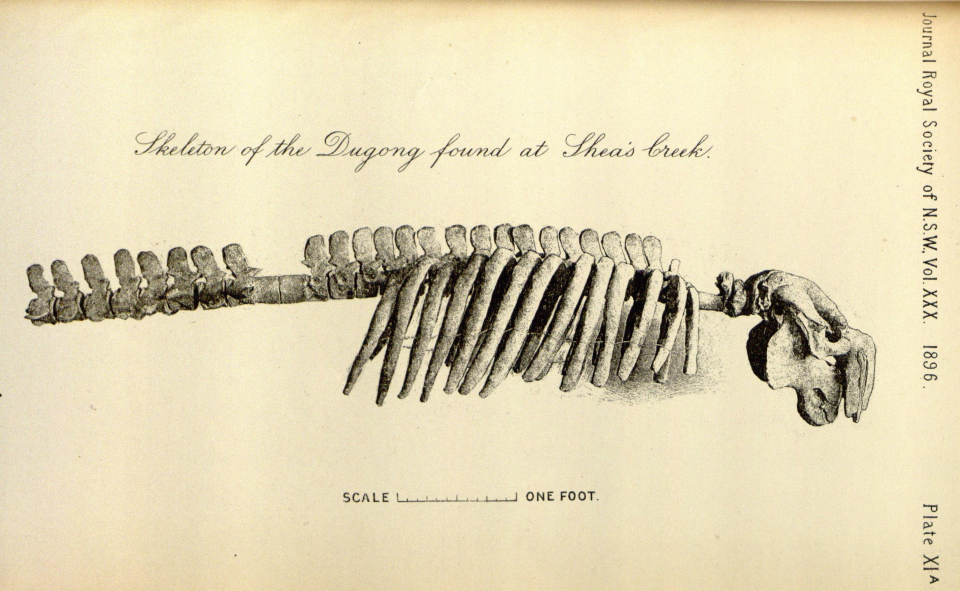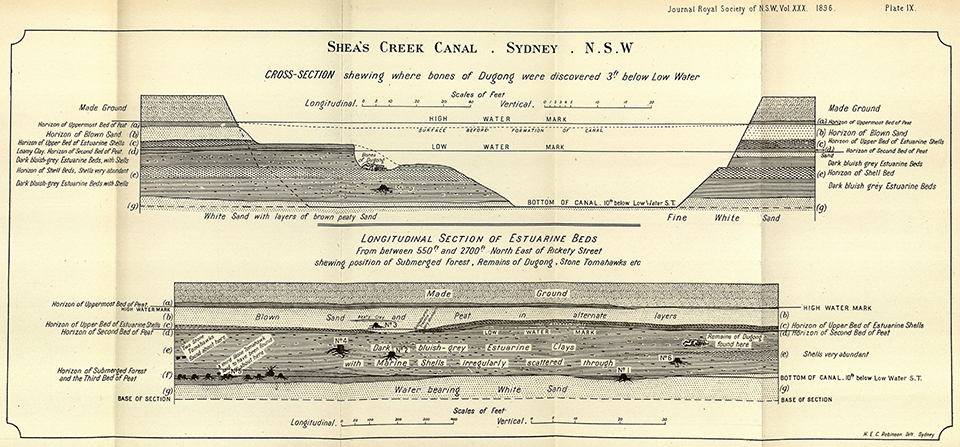The Dictionary of Sydney was archived in 2021.
The Dugong and the Salamander
 Excavation of dugong remains at Sheas Creek 1896 , Courtesy Australian Museum Archives (AMS351/V9817)
Excavation of dugong remains at Sheas Creek 1896 , Courtesy Australian Museum Archives (AMS351/V9817)
Listen to Minna and Alex on 2SER here
For 80 million years, starting 270 million years ago, a huge amount of sediment was deposited in the Sydney Basin, burying the remains of animals and plants that had lived long ago. One such creature caught in the sediments of time was the Paracyclotosaurus davidi or a giant salamander-like amphibian. The remains of the 2.75m creature resurfaced at the St Peters Brickyards (today’s Sydney Park) in 1910. Found as a complete fossil skeleton, it dated from the Triassic period some 250-205 million years ago where it lurked in the lakes of the Sydney basin.[i] Sadly it travelled onward and now lives in the Natural History Museum in London. Cast of full skeleton of Paracyclotosaurus davidi at the Natural History Museum 2011, Trustees of the Natural History Museum, London (CC BY 4.0)
Cast of full skeleton of Paracyclotosaurus davidi at the Natural History Museum 2011, Trustees of the Natural History Museum, London (CC BY 4.0)
 Skeleton of the Dugong found at Shea's Creek 1896, Plate XIa, 'On the occurrence of a submerged forest, with remains of the Dugong, at Shea's Creek near Sydney' by R Etheridge, Junr, Professor TW Edgeworth David, BA, FGS, and HW Grimshaw, M Inst CE, Journal and proceedings of the Royal Society of New South Wales, Vol 30, 1896, p 158 via the Internet Archive
Skeleton of the Dugong found at Shea's Creek 1896, Plate XIa, 'On the occurrence of a submerged forest, with remains of the Dugong, at Shea's Creek near Sydney' by R Etheridge, Junr, Professor TW Edgeworth David, BA, FGS, and HW Grimshaw, M Inst CE, Journal and proceedings of the Royal Society of New South Wales, Vol 30, 1896, p 158 via the Internet Archive
 Cross section and longitudinal section of Shea's Creek Canal shewing position of submerged forest, remains of dugong, stone tomahawks etc 1896, Plate IX, 'On the occurrence of a submerged forest, with remains of the Dugong, at Shea's Creek near Sydney' by R Etheridge, Junr, Professor TW Edgeworth David, BA, FGS, and HW Grimshaw, M Inst CE, Journal and proceedings of the Royal Society of New South Wales, Vol 30, 1896, p 158 via the Internet Archive
Cross section and longitudinal section of Shea's Creek Canal shewing position of submerged forest, remains of dugong, stone tomahawks etc 1896, Plate IX, 'On the occurrence of a submerged forest, with remains of the Dugong, at Shea's Creek near Sydney' by R Etheridge, Junr, Professor TW Edgeworth David, BA, FGS, and HW Grimshaw, M Inst CE, Journal and proceedings of the Royal Society of New South Wales, Vol 30, 1896, p 158 via the Internet Archive
Categories
Blog
2SER Breakfast
Aboriginal history
Alex James
Alexandria
animals
dugong
excavation
fossils
Minna Muhlen Schulte
palaeontology
Paracyclotosaurus davidi
prehistory
Sheas Creek
sydney history
Sydney Park




